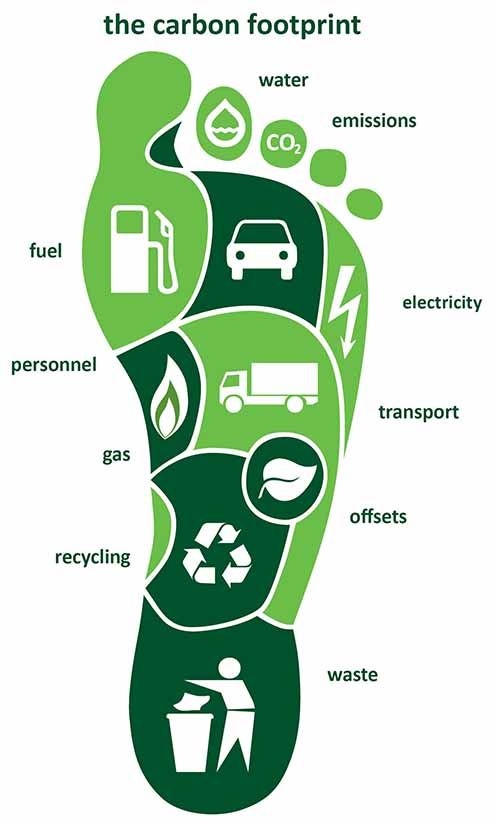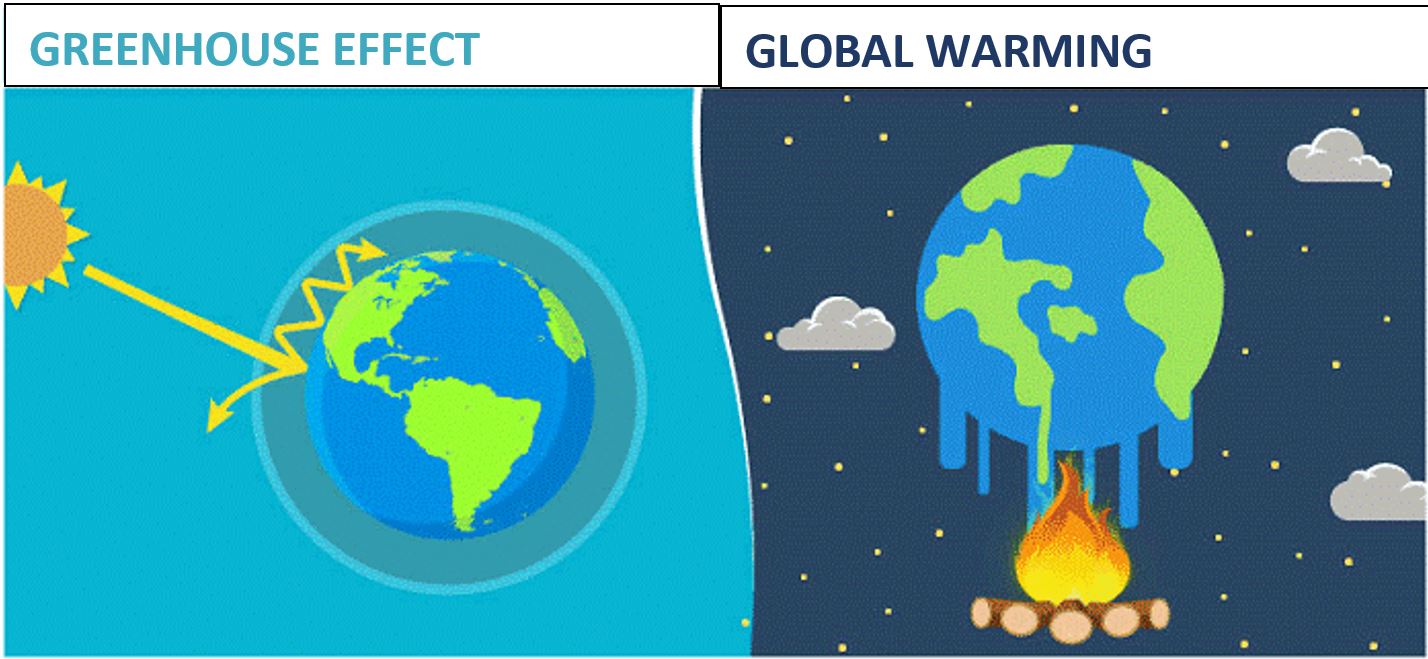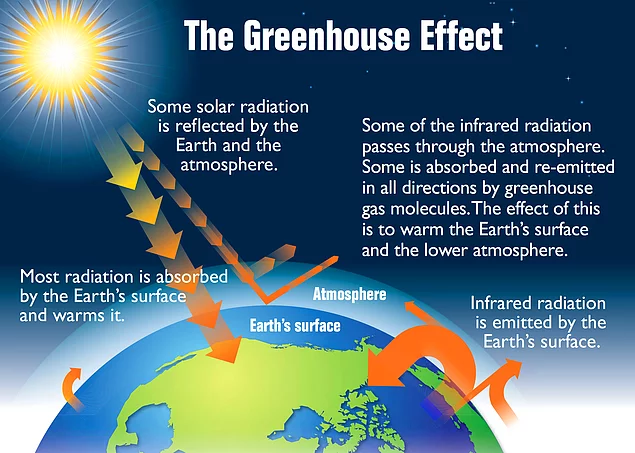 What is carbon footprint?
What is carbon footprint? Carbon footprint is the total amount of greenhouse gases produced to directly and indirectly support human activities, usually expressed in equivalent tons of carbon dioxide.
The carbon footprint includes both direct and indirect sources of emissions—direct being emissions attributed directly to an individual and indirect being carbon dioxide created by a country or production process, attributed to a person living in that country.
Main Contributors to Carbon Footprint •
Energy – Here, carbon footprint emissions are collective, coming from a variety of sources, namely industrial processes, transport and electricity and fuel emissions.
•
Industrialization – Since the industrial revolution began during the middle of the twentieth century, CO2 has continued to rise unchecked and at alarming rates.
•
Agriculture – Most agricultural processes within developed and developing nations are still being carried out commercially with the result that mass production of livestock has led to large levels of methane gas being released into the atmosphere.
•
Waste – No matter which process or activity is being carried out, the waste from these is excessive. It is also having a harmful impact on the earth’s natural resources (flora, fauna and the oceans).
•
Human action (and inaction) – Ultimately, the way humankind has become accustomed to doing things every day, keeping pace with the need to do things more quickly and with more convenience, has contributed towards the exponential increase in carbon footprints on an annual basis.
Why is Carbon Footprint Calculated? • Legal obligation
• Corporate social responsibility
• Demands of customers or investors
• Marketing and organizational image
• Greenhouse Gas Emission Reduction (mandatory / voluntary)
• Participation in emissions trading mechanisms
How is Carbon Footprint calculated? The organization, which wants to calculate the carbon footprint, can use any of the following international standards;
• GHG Protocol
• PAS 2060
• ISO 14064
How to Reduce Your Carbon Footprint? •
Driving – Hybrids may still be out of reach of most drivers, mainly due to its price, but it is a necessary alternative to conventional vehicles run on petrol or diesel. Also, when driving, motorists should avoid heavily congested road networks. How well they drive also makes an impact on reducing their carbon footprint.
•
Instead of driving – The popular and healthy advice is to walk instead of driving. Those who have too far to travel can also use rapid bus transport networks and urban rail networks.
•
Less red meat – Vegetarians are already off to a good start because most of their consumptive waste can be recycled easily. However, the greenhouse gas emissions from agricultural produce such as cattle and poultry are substantial. Where there is less demand surely emissions can be reduced.
•
Buy local – Adding to the above remark, buying local, organic produce effectively counters mass-produced agricultural outcomes. There is a dramatic reduction in the amount of plastic being used to package products and fuel usage during long road transits is also reduced.
•
Energy efficiency at home – All appliances that are not being used must be switched off immediately. And all electrical outlets not in use must also be switched off. Hot-water geysers should be switched off for the entire day and only turned on when needed. These are simple, yet practical lifestyle habits which are easy to adopt.
•
Buy green energy – It is quite possible to power your own home with environmentally-sustainable alternatives of energy production without compromising your lifestyle and waiting for national grids to be connected via green energy supply sources. For instance, technology is now available for you to install your own solar power panels.
•
Recycle and re-use – Vegetable produce can be converted into compost (or manure) for gardens, even vegetable gardens. Instead of buying more food containers, plastic containers sourced from the supermarket can be refashioned as ideal kitchen utensils. Also, where plastic waste is no longer required, seek out recycling depots rather than relying on your supplied garbage disposal units.
•
Avail WFH Facility – Do you really need to go to office to complete your daily work? If you have an option to work from home even for couple of days in a week, just opt for it. It will reduce the huge CO2 burden in case you are using your own vehicle for commuting. Do you really need to fly and attend business meetings or conferences? Why not make use of teleconferences and attend these meetings remotely? It may not be possible every time but even if you are able to do skip couple of meetings in a month, that will make a huge difference.
•
Purchase Carbon Credits – For some companies or private individuals, some emissions are unavoidable. For those, purchasing carbon credits is a worthwhile option. This is done by purchasing these carbon credits from companies who will invest those dollars on their behalf on some renewable energy and energy efficiency projects.
•
Plant a Tree – One of the best way to give it back to the environment is to plant trees. Plants absorb CO2 and release oxygen that is then used by humans and animals. According to the Urban Forestry Network, a single young tree absorbs 13 pounds of carbon dioxide each year.
GREENHOUSE GASES
A greenhouse gas is a gas that absorbs and emits radiant energy within the thermal infrared range.
Gas Name Approximate Ratio of Greenhouse Gases Carbon dioxide (CO2) %72
Methane (CH4) %19
Nitrous oxide (N2O) %6
Fluorinated Gases %3
- Hydrofluorocarbons (HFCs)
- Perfluorocarbons (PFCs)
- Sulfur hexafluoride (SF6)
Greenhouse Effect The greenhouse effect is the process by which radiation from a planet's atmosphere warms the planet's surface to a temperature above what it would be without this atmosphere. Without greenhouse gases, the average temperature of Earth's surface would be about −18 °C, rather than the present average of 15 °C.
 Greenhouse Gas Emissions
Greenhouse Gas Emissions Amount of greenhouse gases in the atmosphere indicates greenhouse gas emission. The primary sources of greenhouse gas emissions from human activities are from burning fossil fuels for electricity, heat and transportation, agriculture, industry, land use and forestry.
How to Measure Greenhouse Gas Emission? The measurement of greenhouse gas emissions can be done in the formats determined by the Ministry of Environment and Urbanization by people trained in flue gas and emission within the scope of Environment and Emission permission.
How to Reduce Greenhouse Gas Emissions? • Investments should be made in renewable energy sources.
• Energy consumption should be reduced.
• Consumption should be made if needed.
• Wastes should be collected separately and sent for recycling.


 What is carbon footprint?
What is carbon footprint?